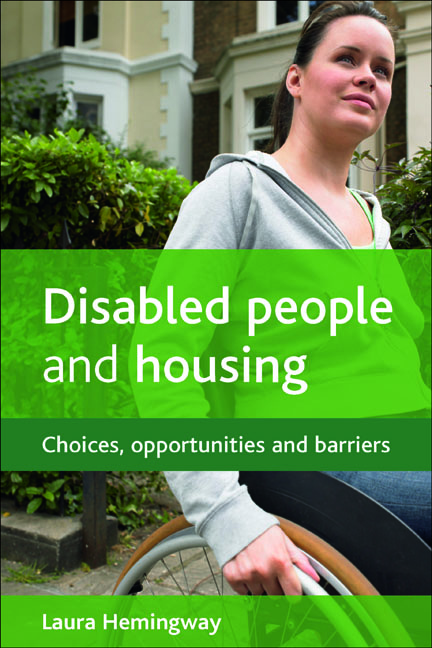Book contents
- Frontmatter
- Dedication
- Contents
- Acknowledgements
- one Introduction
- two Housing policy and disabled people: from past to present
- three Understanding disability: from ‘personal tragedy’ to social disadvantage
- four Physical and communication barriers: the built environment and access to information
- five Financial considerations: income, affordability and risk assessment
- six Attitudinal constraints: assumptions and institutional practices
- seven Creating the ‘home’ in a society of barriers
- References
- Websites
- Index
four - Physical and communication barriers: the built environment and access to information
Published online by Cambridge University Press: 07 September 2022
- Frontmatter
- Dedication
- Contents
- Acknowledgements
- one Introduction
- two Housing policy and disabled people: from past to present
- three Understanding disability: from ‘personal tragedy’ to social disadvantage
- four Physical and communication barriers: the built environment and access to information
- five Financial considerations: income, affordability and risk assessment
- six Attitudinal constraints: assumptions and institutional practices
- seven Creating the ‘home’ in a society of barriers
- References
- Websites
- Index
Summary
The built environment plays a key role in ‘… shaping the ways in which people lead their lives’ (Imrie and Hall, 2001, p 333), yet it poses a challenge for many disabled and older people in both public and private spheres, segregating, excluding and restricting movement. The design of buildings, public amenities and streets; the presentation and positioning of signs; and the inaccessible transport system neglect to cater for diversity in the human body, creating an environment that excludes almost everyone at some point in their lives (a process some have referred to as ‘architectural disablement’; see Goldsmith, 1997). While everyone can potentially be affected by building design, disabled and older people are disproportionately ‘designed out’ of the physical environment, which restricts their opportunities to participate in the everyday life of society (Imrie, 1996; Burns, 2004). Much like the architecture of the public sphere, the design of housing rarely considers diversity in the human form and as such, the general stock of housing in the UK has been designed primarily for the non-disabled population. It is not just the experience within the home that is important, for there are various components of housing as a physical dwelling that need to be considered. So while access into the home, movement around the inside of the dwelling and general usability of facilities within it are all important, the accessibility of the immediate environment outside the dwelling (for example, the garden and communal areas) and the surrounding neighbourhood also require consideration. Furthermore, albeit that barriers created by physical design are experienced more commonly by people with mobility impairments (Imrie, 2006a), people with a range of impairments encounter these types of barriers, such as people with visual or hearing impairments or mental health service users. It is these issues that form the focus of this chapter. In addition, access to appropriate information, communicated in an accessible and effective format, is essential to disabled people making informed choices about housing and allied services. This chapter therefore also explores information and communication issues within the housing and mortgage industries.
- Type
- Chapter
- Information
- Disabled People and HousingChoices, Opportunities and Barriers, pp. 67 - 98Publisher: Bristol University PressPrint publication year: 2011

